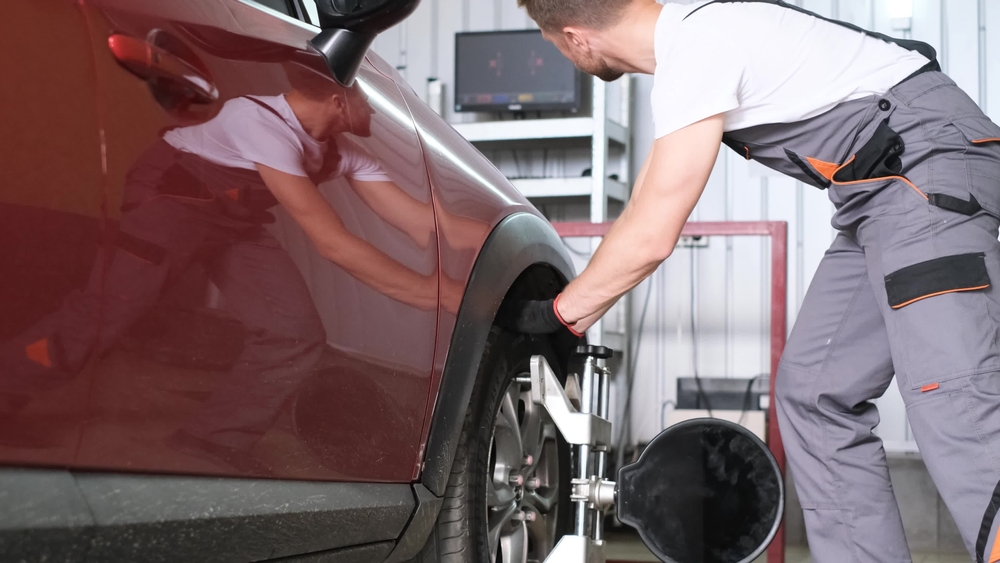
Wheel Alignment Or Wheel Balancing: What’s The Difference?
July 1, 2024 2:07 pmMaintaining your vehicle’s health can sometimes feel like decoding a complex puzzle. Among the many aspects of vehicle maintenance, wheel alignment and wheel balancing often create confusion. While both are crucial for a smooth and safe driving experience, they serve different purposes. In this blog, we’ll explore the differences between wheel alignment and wheel balancing, helping you understand when and why each service is needed.
What is Wheel Alignment?
Wheel alignment involves adjusting the angles of the wheels so they are set to the manufacturer’s specifications. This process ensures that your vehicle’s wheels are oriented correctly, which is essential for even tire wear and optimal handling. The key angles involved in wheel alignment are:
- Camber: The inward or outward tilt of the tire when viewed from the front of the vehicle. Improper camber can cause uneven tire wear on one side.
- Toe: The extent to which the tires turn inward or outward when viewed from above. Incorrect toe settings can lead to tire feathering.
- Caster: The angle of the steering axis when viewed from the side of the vehicle. Proper caster helps with steering stability and cornering.
Why Wheel Alignment is Important
When your wheels are misaligned, it can lead to various issues, including:
- Uneven tire wear
- Poor handling and stability
- Increased fuel consumption
- Steering problems
Correcting the angles of your wheels ensures they are parallel to each other and perpendicular to the road. This not only enhances your driving experience but also extends the life of your tires and suspension components.
What is Wheel Balancing?
Wheel balancing is the process of equalizing the weight distribution around the tire and wheel assembly. It involves placing tiny weights on the rim to counterbalance any weight imbalances. A weight imbalance on your tire can cause vibrations, especially at higher speeds.
Signs You Need Wheel Balancing
You might need wheel balancing if you notice:
- Vibrations in the steering wheel, floorboard, or seat at certain speeds
- Uneven tire wear
- Poor fuel economy
Wheel balancing ensures that your tires and wheels spin smoothly at high speeds. This not only improves ride comfort but also prevents premature wear and tear on your tires and suspension.
Key Differences Between Wheel Alignment and Wheel Balancing
Understanding the differences between these two services can help you determine what your vehicle needs:
- Purpose:
- Wheel Alignment: Corrects the angles of the wheels to ensure they are set to the vehicle manufacturer’s specifications.
- Wheel Balancing: Corrects the weight distribution within the tire and wheel assembly to prevent vibrations.
- Symptoms:
- Wheel Alignment: Pulling to one side, uneven tire wear, crooked steering wheel when driving straight.
- Wheel Balancing: Vibrations in the steering wheel or vehicle body, uneven tire wear.
- Service Frequency:
- Wheel Alignment: Typically recommended every 12,000 miles or once a year, but you should check your owner’s manual for specific recommendations.
- Wheel Balancing: Should be checked every time you rotate your tires, usually every 5,000 to 7,500 miles.
- Impact on Vehicle:
- Wheel Alignment: Affects tire wear, handling, and fuel efficiency.
- Wheel Balancing: Affects ride comfort, tire wear, and suspension wear.
When to Seek Professional Help
It’s crucial to have your vehicle inspected by a professional if you notice any symptoms of misalignment or imbalance. Regular maintenance checks can help identify these issues early and prevent more severe problems down the road. Remember, maintaining proper wheel alignment and balance is not just about comfort; it’s about safety and the longevity of your vehicle.
Conclusion
While both wheel alignment and wheel balancing are vital for your vehicle’s performance, they address different aspects of the driving experience. By understanding the differences and recognizing the signs, you can ensure your vehicle stays in top condition, providing you with a safer and more enjoyable ride.
If you’re experiencing any issues with your vehicle’s handling or ride quality, don’t hesitate to visit a trusted mechanic. They can perform the necessary checks and services to keep your wheels perfectly aligned and balanced. Safe travels!
Need an Auto Repair Shop in Chino, CA?
Gabriel’s Automotive & Towing is a full-service auto mechanic and repair shop in Chino, CA. For over 20 years, our auto repair shop has provided expert automotive technicians that are highly trained in both foreign and domestic vehicles. It is always our goal to satisfy you and enable you to get the most out of your vehicle. A well-maintained vehicle will give you years of enjoyment. We specialize in BMW vehicles and offer work on a variety of parts, including brakes, carburetors, charging systems, air conditioning systems, electrical components, and emissions. We also perform diesel tune-ups and repairs. For drivers throughout Chino and Chino Hills, CA, give us a call or stop by the shop today!
Categorised in: Wheel Alignment, Wheel Balancing
This post was written by admin
